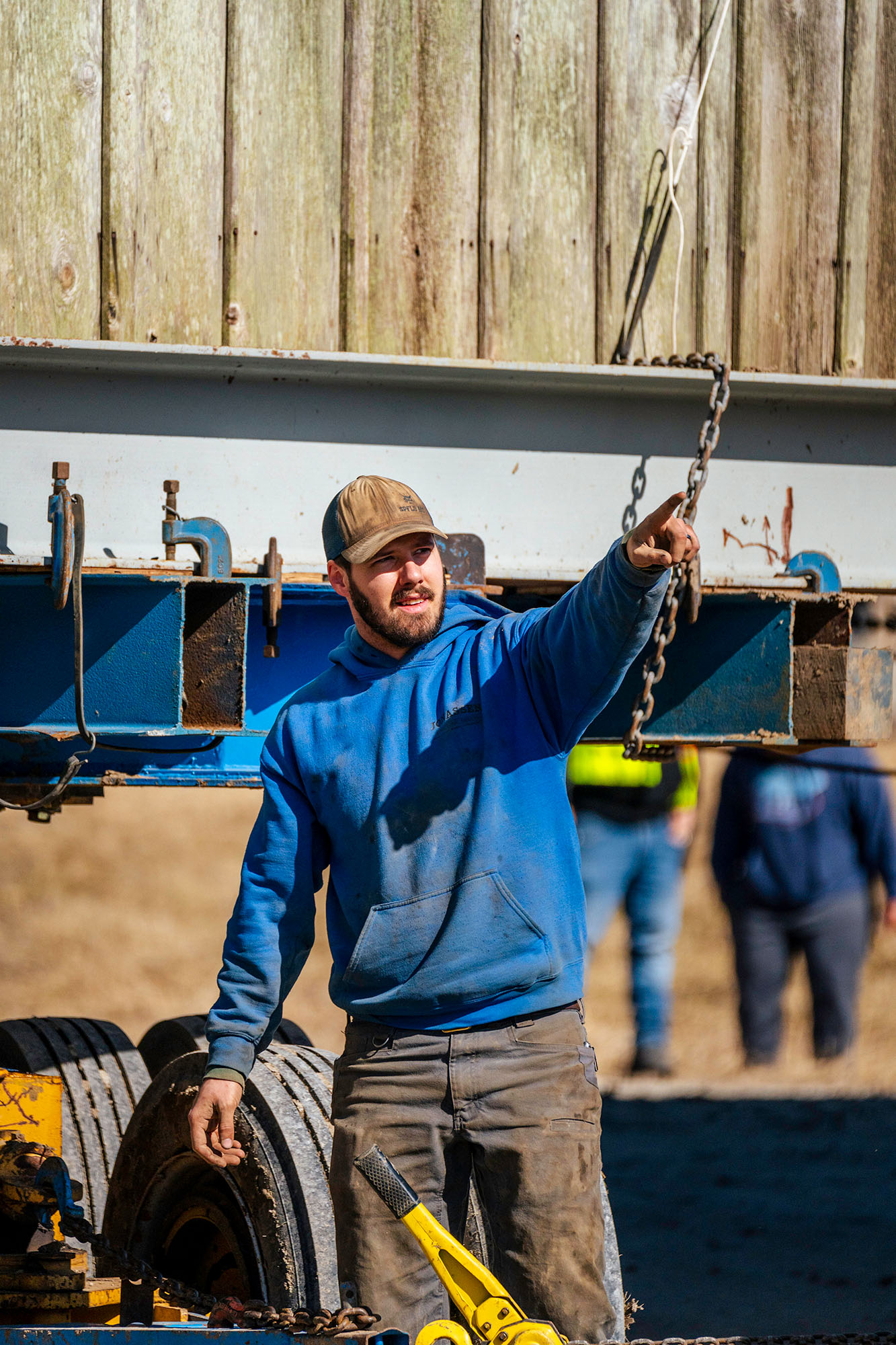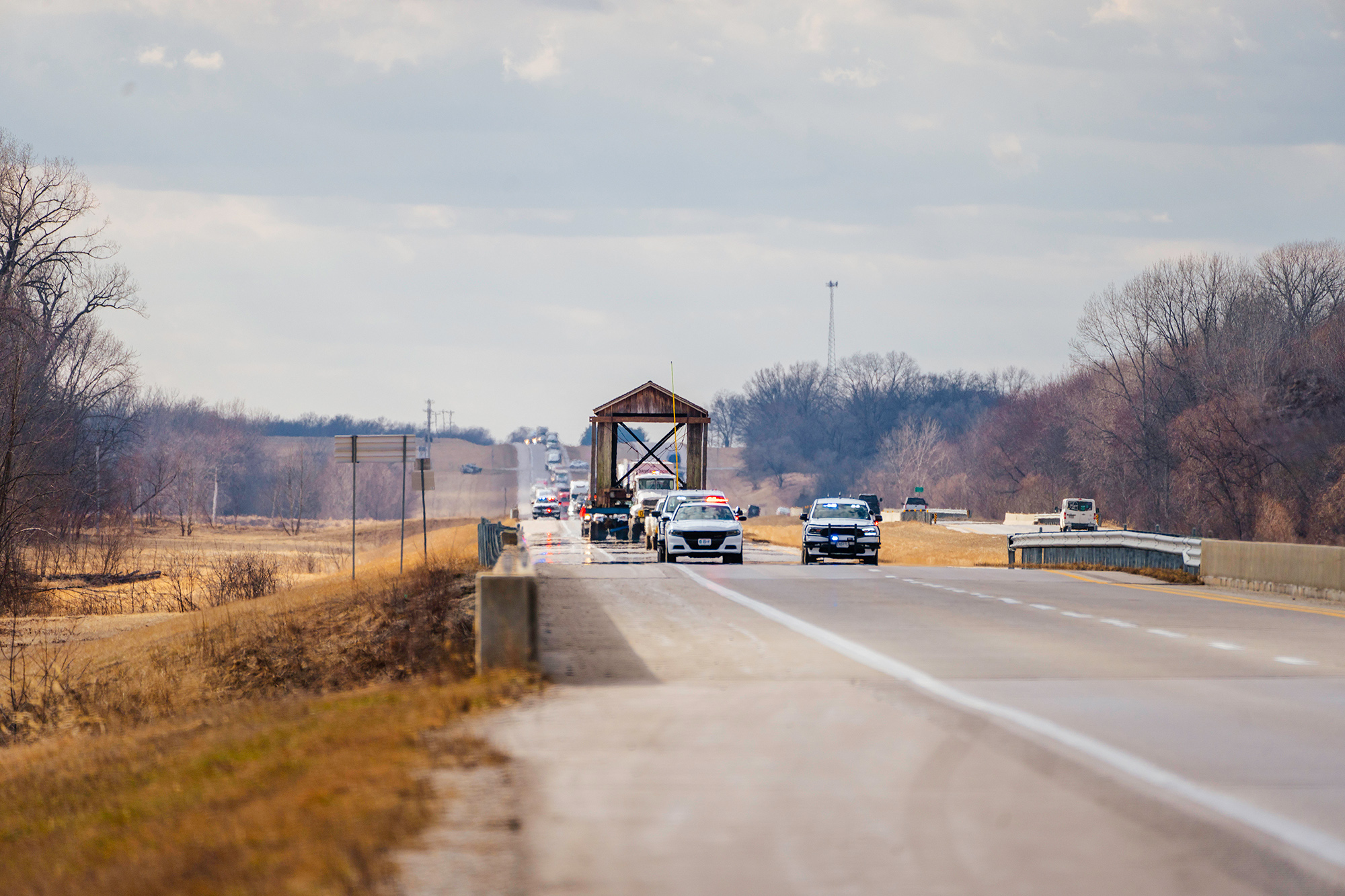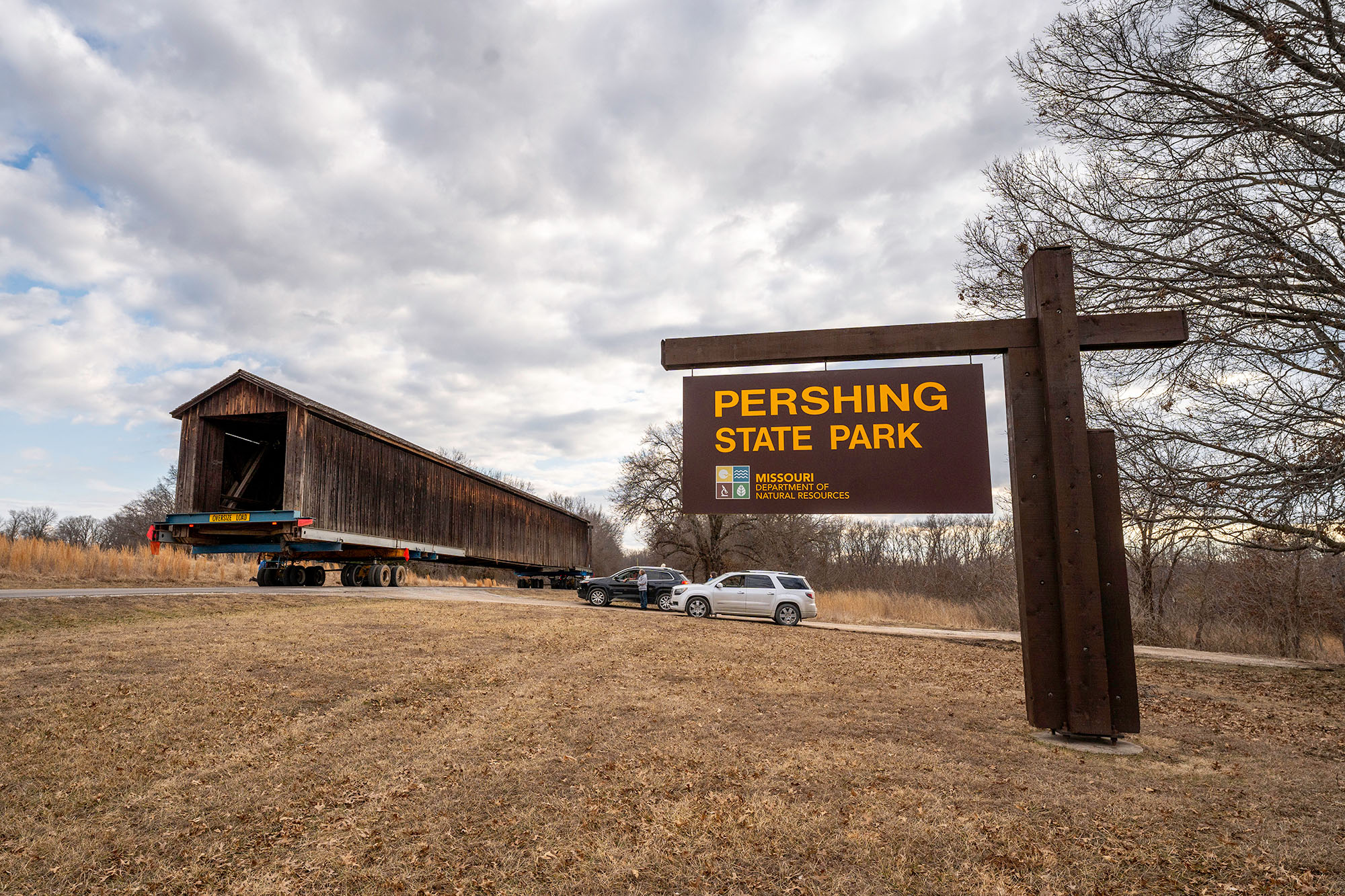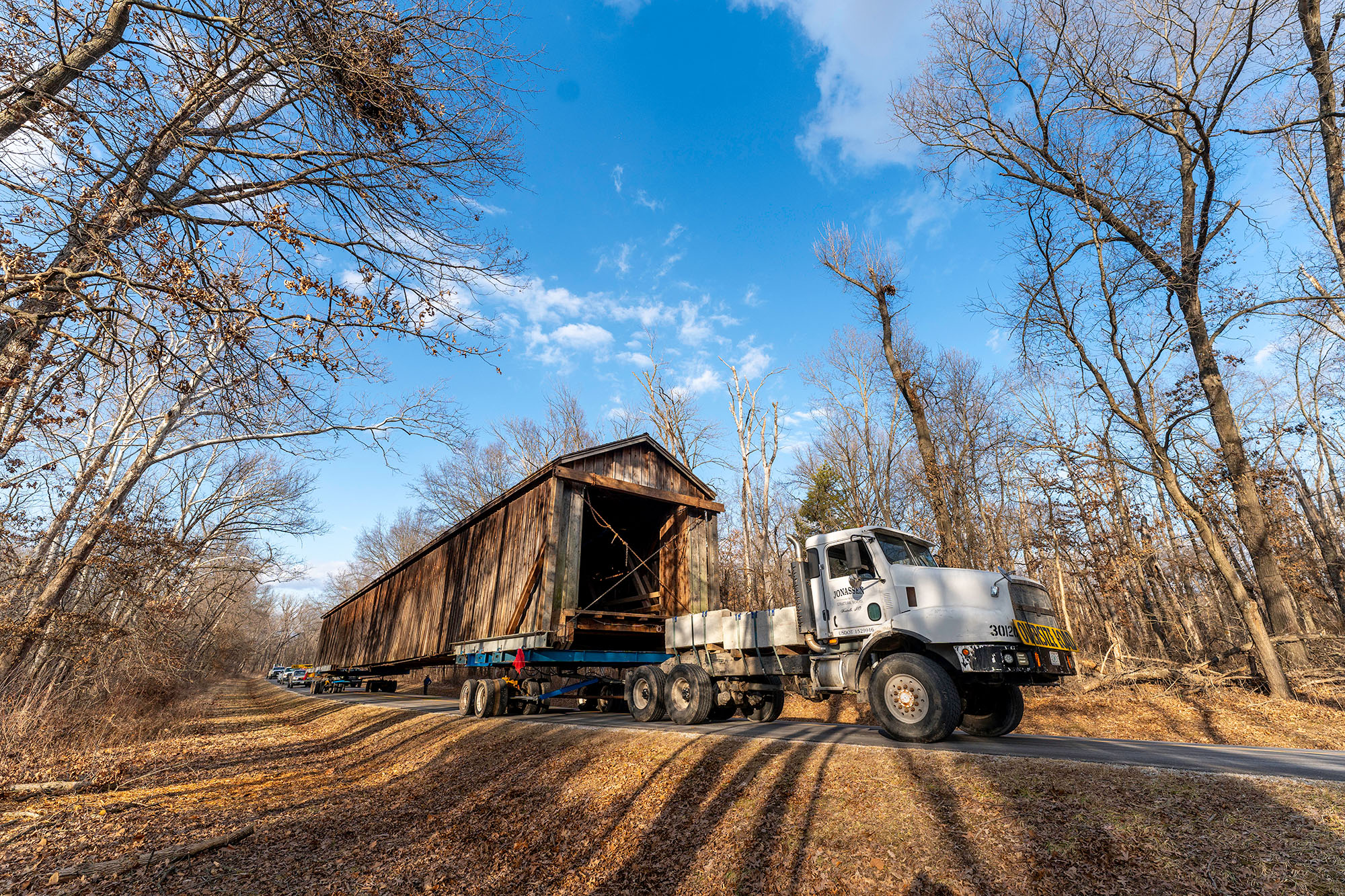Locust Creek Covered Bridge makes its way through Pershing State Park to its new home.
Published by
on
How many people does it take to move a 151-foot, 62.5-ton, 157-year-old covered bridge during winter in northeast Missouri? (Answer: Only three!) Missouri State Parks was at risk of losing Locust Creek Covered Bridge forever and desperately needed a miracle. To save the vulnerable structure, it had to be carefully moved to a new home where it could undergo critical restoration before it was too late.
Built in 1868 by the firm Bishop and Eaton, Locust Creek Covered Bridge once connected one of the nation’s earliest transcontinental roads. The bridge, built of white pine, used the Howe-truss system, which was named for William Howe who patented the design in 1840. The design features use of vertical iron rods to draw the diagonal wooden members tight against the structure’s top and bottom. The bridge also features rectangular entrances with ramps sloping away from both ends.
Locust Creek Covered Bridge is the longest of Missouri’s four remaining covered bridges. Originally located over Locust Creek off Route 8 in northeast Missouri, it served as a main route for horse-drawn wagons and buggies. Gradually, these were replaced with cars and in 1930, U.S. Highway 36 replaced Route 8, and Locust Creek Covered Bridge would no longer serve as part of a transcontinental road.
In 1967, the Missouri Legislature passed a bill authorizing the Missouri State Park Board to take possession of, repair and preserve the then-five remaining covered bridges in the state, which included Locust Creek. Two years later, after restoration, the bridge was placed on the National Register of Historic Places.
Over time, most of Locust Creek’s channel straightened, leaving the bridge spanning a dry creek bed. Floodwaters deposited topsoil, filling the empty creek bed and causing the bridge to rest almost on the ground. In 1991 and again in 2002, Missouri State Parks raised the bridge 6 feet, renovating the approaches and abutments, to give it the appearance of an actual bridge and also to protect its floor from the wet ground.

Floodwaters have continued to deposit silt and soil, leaving the bridge to all but rest on the ground once more. Without moving it, the bridge would rot away until nothing but memories remained.
“We were in danger of losing the bridge due to the instability of the watershed,” said Brett Barnes, a deputy regional director with Missouri State Parks. “Something needed to be done, or that piece of history would be lost forever.”
Dustin Webb, Northern Region director with Missouri State Parks, concurred. “Access over Higgins Ditch to visit Locust Creek Covered Bridge continued to become more of a challenge. This simple drainage ditch from the 1930s became the primary route for all the water that used to flow down Locust Creek,” said Webb. “Sedimentation and numerous logjams have redirected all flows down the ditch. Each high-water event results in a substantial deterioration of Higgins Ditch at the Locust Creek Covered Bridge State Historic Site parking lot and footbridge.”
After much plotting, preparation and planning, Jonassen Structural Movers, LLC. received the contract to move the bridge. Joe Jonassen is no stranger to moving large structures. Normally, he moves houses, but he has moved a 150’x80’ warehouse, a 124-ton building and a few structures that were 30-40 feet tall. While there is no school for moving houses, Jonassen said he has several family members who are in the trade across the country, and he has learned from them.
Jonassen got into the business after forming a partnership with his brother. In 2022, his brother passed away, and Jonassen made the decision to keep the company going. While self-taught, he uses his background and general construction knowledge to figure things out. The work is stressful, dirty and sometimes means working in all types of weather.
“Moving houses is a dying trade. It’s a close-knit industry where even competitors help each other out,” Jonassen said. He never thought his small-town, family-owned business from Hartville would move a covered bridge in northern Missouri, but he was excited about the opportunity.
“It takes a special dynamic to work this type of job,” Jonassen said. “I like to keep my crew small and make sure they all have general labor experience. It helps to have a well-rounded background because you never know what you’re going to get into.”

What’s the plan?
Talks of moving the bridge began in earnest two years ago. Missouri State Parks team members knew the bridge housed bats, and after a bat study they found it to be home to the Indiana bat species. Not only did they need to consider how to get a bridge across a creek and highway, but also how to move a structure that is home to the largest known maternal Indiana bat colony in Missouri.
“It took a lot of planning and a lot of teamwork to get this figured out,” said Webb. “We definitely didn’t want to disturb the bats, but we also didn’t want to lose this historic bridge either, and we were in danger of that happening. If something wasn’t done soon, we’d lose the footbridge and trail to the covered bridge and, in essence, lose all access to the bridge. Loss of access would create an ‘inaccessible island’ where no visitors could see the site, staff could not maintain it, and emergency response would be impossible.”
Working with the U.S. Fish and Wildlife Service, Missouri State Parks found a solution for the bats, and they have been provided with other options for their return home.
Jonassen and two employees were the ones who undertook the challenge of moving the structure, with the support of state park team members who completed much of the required prep work. Of course, the bridge needed a new location.
“We needed to find a place to move the bridge that wasn’t too far away and was over water,” said Webb. “Pershing State Park, which is about 5 miles away, turned out to be the perfect spot. The bridge will be back over Locust Creek, which makes it feel more like how it was when it was originally built. The bridge will also serve as the trailhead to the existing boardwalk trail. Parking and access will be simple, and more visitors will be able to experience the covered bridge in its new location.”
Engineers concocted a plan to move the bridge across the creek with a destination in mind. The bridge would need to be turned 180 degrees so that when it was set in its new location, it would face the same direction it did originally. To do this, a path had to be cleared to turn it. Finally, the bridge had to not only cross the creek, but also cross a busy state highway, U.S. Highway 36. Permits were needed to move the bridge, so help was offered from the Missouri Department of Transportation.

“I love history and moving the bridge was a unique challenge, and really a lot of fun. It’s not the usual cookie-cutter stuff. When I first looked at the bridge, I thought it was going to be a lot more difficult, but after getting to work on it, I’ve found the bridge is self-supporting and a really tough structure. It’s well-built, stable and resilient,” Jonassen said. “While house moving is our bread and butter, learning about and preserving history is important. I’m glad to be a part of this opportunity so we can enjoy the bridge for another 150 years or more. I also really enjoy geologic history and love watershed history, so this has been an interesting and enjoyable project to learn about and work on.”
“At one time, Missouri had 30 or so covered bridges. Now, Missouri State Parks manages the four that remain,” said Webb. “The last thing we wanted to do was to relocate the historic bridge, but it’s the only way that we can protect it for future generations.”
To plan your visit to see Locust Creek Covered Bridge, visit mostateparks.com.





